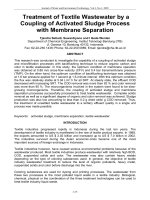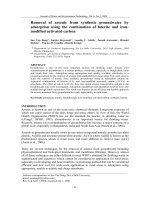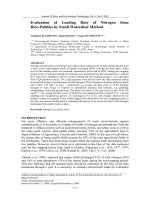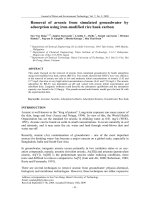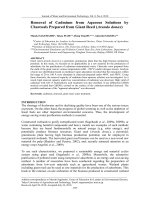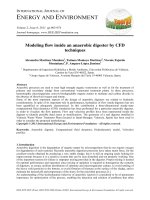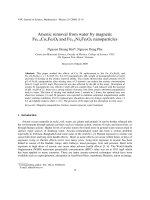Colour removal from textile effluents by adsorption techniques
Bạn đang xem bản rút gọn của tài liệu. Xem và tải ngay bản đầy đủ của tài liệu tại đây (222.08 KB, 3 trang )
Wat. Res. Vol. 25, No. 3, pp. 271-273, 1991
Printed in Great Britain
0043-1354/91 $3.00 + 0.00
Pergamon Press pie
COLOUR REMOVAL FROM TEXTILE EFFLUENTS BY
ADSORPTION TECHNIQUES
MOHAMMAD S. EL-GEUNDI
Department of Chemical Engineering, Faculty of Engineering, Minia University, E1-Minia, Egypt
(First received January 1990; accepted in revisedform September 1990)
Abstract--The adsorption of two basic dyestuffs (Atrazon Blue and Maxilon Red) and two acid dyestuffs
(Telon Blue and Erionyl Red) onto maize cob was studied. High adsorptive capacities were observed for
the adsorption of basic dyestuffs, namely, 160 and 94.5 mg dye per g maize cob for Astrazon Blue and
Maxilon Red, respectively. Lower capacities were obtained with the acid dyestuffs, namely, 47.7 and
41.4 nag dye per g maize cob for Erionyl Red and Telon Blue, respectively. A series of contact-time
experiments was undertaken in an agitated batch adsorber to assess the effect of the system variables,
namely, agitation speed, maize cob particle size and maize cob mass. The experimental results for these
contact-time experiments were discussed.
Key words--dyestuffs, maize cob, adsorption capacity, adsorption rate
NOMENCLATURE
a~ =
Co =
C, =
Ct =
KL =
M =
qc =
t=
EXPERIMENTAL
Maize cob used in this study as an adsorbent was collected
from EI-Minia Governorate, Egypt. It was cut to particle
size ranges 250-355, 355-500, 500-710 and 710-1000#m.
It was left (for 3 days) to equilibrate to a fixed moisture
content (14 + 0.3%) prior to sieving and experimental work.
Maize cob was not subjected to any form of pretreatment
prior to use.
Four dyestuffs were used as adsorbates. The dyestuffs
used in the experiments are listed in Table 1.
All concentrations were measured at the wavelength
corresponding to maximum absorbance, 2m~, using spectrophotometer (Spectro-Plus MK1A). Dilutions were undertaken when absorbance exceeded 0.6.
Adsorption isotherms were determined by the bottlepoint method (El-Geundi, 1987). A constant mass of maize
cob was added to bottles containing 50-ml of dye solution
(different initial concentrations). The bottles were sealed
and, together with appropriate controls, mechanically
shaken for a period of 5 days. Resultant solution concentrations were then determined, the equilibrium data from
each such bottle representing one point on an adsorption
isotherm.
Several contact-time experiments were undertaken in an
agitated batch adsorber to study the effect of a number of
the system variables contact-time. The design and details of
the batch adsorber used in the kinetic studies have been
reported previously (EI-Geundi, 1987).
Langmuir isotherm constant (dm 3mg- t )
initial liquid-phase concentration (rag dm -3)
equilibrium liquid-phase concentration (mg dm -3)
liquid-phase concentration at time t (mg dm -3)
Langmuir isotherm constant (dm 3g- i )
mass of adsorbent (g)
equilibrium solid-phase concentration (mg g- ~)
time (min).
INTRODUCTION
Adsorption is rapidly gaining prominence as a
method of treating aqueous effluents. The treatment
of aqueous effluents in countries in the Middle and
Far East is extremely important as a means of
conserving and recycling water. The rapidly growing
textile industries in these areas of the world produce
large quantities of effluents. Most conventional
adsorption systems use activated carbon which is
expensive and necessitates regeneration (McKay,
1981, 1982).
In Egypt, a vast amount of maize cob is available
as agricultural waste. The aim of the present work is
to test the ability of maize cob to adsorb dyestuffs.
The maize cob plus adsorbed dye could then be
burned as much of it is used as a fuel already.
Isotherm studies have been undertaken to determine
the maximum adsorption capacity of maize cob for
dyestuffs, namely Astrazon Blue F R R , Maxilon Red
BL-N, Telon Blue A N L and Erionyl Red RS. In
addition a series of contact-time experiments was
undertaken using an agitated batch adsorber to
study the effects of a number of factors on the rate
of adsorption. These factors are agitation speed,
adsorbent mass and maize cob particle size range.
RESULTS AND DISCUSSION
Equilibrium isotherms
The capacity of maize cob for various dyestuffs can
be determined by measuring equilibrium isotherms.
Adsorption isotherms were analysed according to the
linear form of the Langmuir isotherm:
Ce/qo = I/K~ + (aL/KL) Co.
The plots of the isotherms are shown in Fig. 1 and
are seen to be linear over the whole concentration
271
272
MOHAMMAD S. EL-GEUNDI
Table 1. List of dyestuffs chosen for the present study
No.
1
2
3
4
Colour
Type
of dye
Supplied
by
2max
(nm)
Telon Blue A N L
Erionyl Red RS
Maxilon Red BL-N
Astrazon Blue F R R
62055
23635
11055
--
Blue
Red
Red
Blue
Acid
Acid
Basic
Basic
Bayer
Ciba--Geigy
Ciba-Geigy
Bayer
600
522
538
585
//
4.8
.,/~
/
~o
/
A/"
d
C.I.
Commercial name
dye base and this will undergo attraction on
approaching the anionic maize cob structure.
The molecular volumes of dyes are 650 x 10 -24 and
690 × 10-:4 cm 3 molecule -~ for Astrazon Blue and
Telon Blue, respectively (McKay, 1982), then there
is not much difference in size between the dye
molecules. Consequently, the molecular mobility in
solution and in the adsorbent must be similar and
therefore not responsible for the different adsorption
capacities.
A AstrazonBLue
• Moxiton Red
~
ra
Etionyt Red
1.6
Batch contact-time studies
i • "D"
~
I
0
dp • 250- 355/.¢m
T=25°C
I
80
160
Ce ( mg.drr; 3)
I
I
240
Fig. 1. Langmuir plot for the adsorption of dyestuffs onto
maize cob.
range. The parameters, KL and a L of the Langmuir
have been calculated for various dyestuffs and are
listed in Table 2. The values of the ratios gL/a L
represent the maximum adsorption capacity of
adsorbent for a particular dyestuff. Table 2 shows
that Erionyl Red has an adsorption capacity of
47.7mgg -1 while that of Telon Blue is 41.4mgg -~.
These two acid dyes would therefore appear to have
similar adsorption capacities while Astrazon Blue
and Maxilon Red have much greater affinities, for
the maize cob adsorption capacities of 160 and
94.5mgg -1, respectively. This difference between
the adsorption capacities of basic and acid dyes is
connected to the nature of maize cob.
The structure of maize cob is cellulose based, and
the surface of cellulose in contact with water is
negatively charged (McKay et al., 1988). Most dyes
are ionized in solution many being salts or sulphonic
or carboxylic acids. While others contain acidic phenolic groups. Teion Blue (Acid Blue 25) is an example
of a dye which ionizes to an anionic coloured component D - and a cation of Na +. The approach of an
acidic dye anion will suffer coulombic repulsion due
to the presence of the strong anionic groups in maize
cob. Astrazon Blue (Basic Blue 69) is an example of
a dye which will ionize to give the coloured cationic
Four series of experiments were undertaken to
study the influence of agitation. The dyes studied
were Astrazon Blue, Maxilon Red, Telon Blue and
Erionyl Red, and the agitation speeds varied from 75
to 600 rev rain- i.
Experimental results for the adsorption of Astrazon Blue on maize cob are shown in Fig. 2. Similar
trends were obtained for all four dyes and the rate of
dye removal was influenced by the degree of agitation
and the uptake increases with stirring rate. The
mechanism of colour removal from effluent involved
four steps: (i) migration of dye molecules from the
bulk solution to the surface of the adsorbent; (ii)
diffusion through the boundary layer to the surface
of the maize cob; (iii) adsorption at a site; (iv)
intraparticle diffusion into the interior of the maize
1.0 ~
L~:I~q,~,.~
~~:~v'l~
0.6
RPM
Co'300 mg.ar~3
m..I.0
q.d~ 3
dp • 355-500p.m
~
°~o
O 7'5
O 250
,',, 4OO
0.4
I
0
I
60
120
Time (min)
I
180
Fig. 2. Effect of agitation on the adsorption of Astrazon
Blue onto maize cob.
Table 2. Parameters in Langmuir isotherm
No.
Adsorbate
KL
(dm 3 g - t )
aL
(dm 3 r a g - i )
qm~
(mg g - i )
Correlation
coefficient
1
2
3
4
Astrazon Blue
Maxilon Red
Erionyl Red
Telon Blue
6.08
2.93
0.668
0.497
0.038
0.031
0.014
0.012
160.0
94.5
47.7
41.4
0,99
0,99
0,99
0,97
Adsorption capacities of dyestuffs
1.O0
®(p.m)
[] 2 5 0 - 355
;R'N,
° 0 0.92
o 5oo-rlO
,,o-,ooo
0.84
0.76
I
0
l
60
120
180
Time(mini
Fig. 3. Effect of particle size range on the adsorption of
Telon Blue onto maize cob.
1.00
0.92
273
observation is in agreement with the proposed mechanism, since the large external surface area (for small
particles) removes more dye in the initial stages of the
adsorption process than the large particles.
The effect of maize cob mass on the adsorption rate
was studied when other experimental conditions were
maintained constant. In all cases the rate of dye
adsorption increased with increasing maize cob mass;
the results are shown in Fig. 4 as a plot of (Ct/Co)
against time for the adsorption of Erionyl Red on
maize cob.
Rate of dye adsorption depends on the driving
force per unit area, and in this case, since Co is
constant, increasing the mass of maize cob increases
the surface area for adsorption and hence the rate of
dye adsorption is increased. Since the particle size
range is constant the surface area will be directly
proportional to the mass of maize cob in the system.
CONCLUSION
o
0.84
& 0.85
E] 1.275
o 1.70
• 2.125
• 3.40
0.76
0
Co, lOOmg.d~3
dp, 500-710/J.m
RPM, 400
I
60
I
120
• ~ A
I
180
Time (rain)
Fig. 4. Effect of maize cob mass on the adsorption of Erionyl
Red onto maize cob.
In laboratory-scale studies, the data show that
maize cob has considerable potential for the removal
of dyestuffs from wastewater over a wide range of
concentrations. The effect of the system variables on
the adsorption of dyestuffs onto maize cob has been
studied, increasing the rate of agitation and the maize
cob mass increases the rate of dye adsorption. Increasing particle size decreases the adsorption rate.
REFERENCES
cob. The boundary layer resistance will be affected by
the rate of adsorption and increasing the degree of
agitation will reduce this resistance and increase the
mobility of the system.
The influence of contact-time on the four ranges
of particle size of maize cob investigated using
the size ranges 250-355, 355-500, 500-710 and
710-1000/~m. The experimental results are shown in
Fig. 3 as a plot of (C,/C0) against time for the
adsorption of Telon Blue on maize cob. The data
show an increase in the rate of dye uptake as the
mean diameter of the adsorbent decreases. This
E1-Geundi M. S. (1987) Mass transfer processes during
colour removal from effluents using adsorption techniques. Ph.D. thesis, The Queen's University of Belfast,
Belfast, U.K.
McKay G. (1981) Design models for adsorption system in
wastewater treatment. J. chem. tech. Biotechnol. 31,
717-731.
McKay G. (1982) Adsorption of dyestuffs from aqueous
solutions with activated carbon I: equilibrium and batch
contact-time studies. J. chem. tech. Biotechnol. 32,
759-772.
McKay G., E1-Geundi M. S. and Nassar M. M. (1988)
External mass transport processes during the adsorption
of dyes onto bagasse pith. Wat. Res. 22, 1527-1533.


